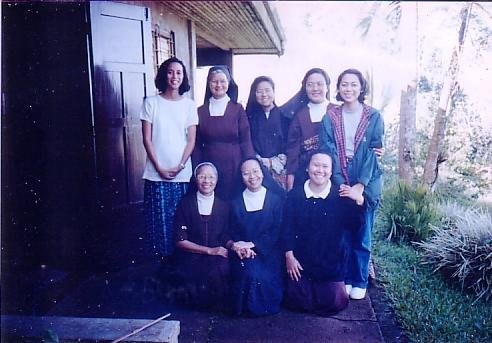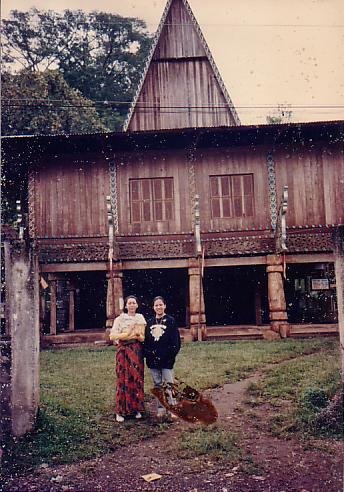I cannot imagine how Marawi City looks like now. I do not even want to know. I prefer to preserve memories of my Marawi twenty years ago when, still fresh-faced and in between jobs, I took time to accompany a friend who began the first steps of her spiritual journey.
Micmic Abello and I spent a week with the Carmelite nuns in Marawi City. Micmic’s aunt Sister Madeleine was Prioress of a small congregation whose convent was set on a hill. The madres made do with whatever they were blessed with in that mainly Muslim city. Marawi, I was told, was 99% Muslim with the rest shared by Catholics, Protestants, and various sects. Unlike the Bacolod monastery where the monjas can depend on the huge Catholic community to provide for their needs, Marawi’s nuns did not have that opportunity.

The Carmelite Nuns of Marawi City
We bathed in rainwater that had been collected in raised concrete receptacles. I remember the frigid water hitting my skin with every splash from the dipper. Although the nuns offered to heat some for us, Micmic and I declined in order to spare them that extra task. There’s nothing that a sharp yelp and jumping up and down won’t warm anyway. I looked at an icy morning bath as part of my mortification.
The nuns would wake us up at 4:00 a.m. for our morning prayers, then, a young American priest (Fr. Paul?) would make the uphill walk to the convent to celebrate Mass in Bisaya in the small Maranao-inspired chapel. The nuns would half-kneel and half-sit on very low individual benches, their heavenly voices filling the convent morning and evening. These were the very nuns who were kidnapped by Muslim rebels during President Cory Aquino’s term to protest against the government. To make sure we were safe, soldiers would check on us every night.
We Had Peace.
If those were dangerous times in Marawi in those days, I wouldn’t know. We never experienced any untoward incident. Well, it helped that we never left the convent unescorted. And I went around like a Maranao for a day – malong, head covering, and a long-sleeved top – looking every inch a fake. Ha ha! We explored their public market, dark and exotic like an island girl. Sheer fabrics from India and batik malongs hung overhead in dizzying array. Outside, a makeshift stall sold brass antiques including crescent-shaped betelnut containers complete with the previous owners’ lime paste still smearing the bottom.
Marawi was a strange planet to me. It transported me to another world that made me wonder if I was still in the Philippines. Men proudly sporting their fezes and the women in black abayas. There were women all covered up except for their eyes; those who showed their faces were surprisingly fully made up. Despite the restraints on the female sex, the ladies are allowed the vanities of fashion and “warpaint”. The priest who drove us around pointed out the Christians from the non-Christians. The Christians were those who went bare-headed and had their shirts and blouses tucked into their pants. Muslim women are not allowed to show off their curves, hence, have to venture out of their homes in their abayas.
What finery is hidden by those robes? Marawi, my Marawi, was dusty and quite not the orderly and modern city that Bacolod was (is?). Yet, like an abaya being shed off to reveal the fashionable garb underneath, Marawi beneath the dust was like silver begging to be polished. Lovely mosques dotted the riverbanks. Capacious torogans were scattered in the city outskirts. And greenery was everywhere.

At a torogan with my lovely guide Lovely
At the convent, I would look out of the window and see the Balaang Bukid across us covered in green and in fog. The convent garden was a haven for birds and the insect world that one Mass go-er quipped that the mosquitoes were “murag Philippine eagle” in size.
I remember Mindanao State University’s vast campus with trees huge and old, their roots snaking aboveground. What a lovely school. It has a golf course, a resort, and a museum. It would have been a pleasure to study there.
It would be a pleasure to see Marawi back on its feet again. Back to the bustle of daily living like the siege did not happen at all. The greenery as green as ever. The shopkeepers calling out to passersby to buy their colorful malongs. The women sashaying by in their black robes; the men planning a trip to Mecca to earn a fez. Probably the monastery reestablished on that hill and the nuns tilling their vegetable patch. That is the Marawi on my mind.
Our minimalistic bedroom at the convent and the convent’s Maranao-inspired chapel

